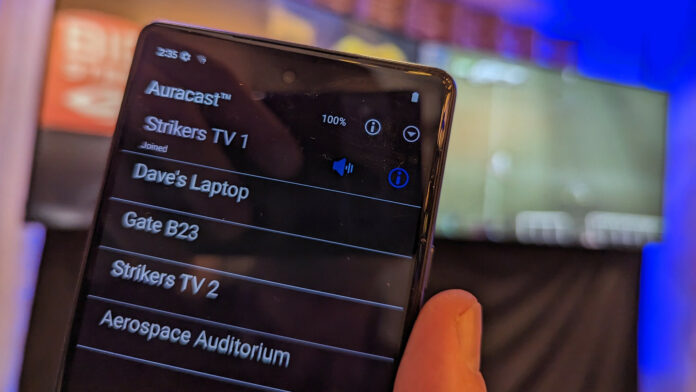BARCELONA—You can think of Bluetooth Auracast(Opens in a new window) as a wireless replacement for the volume-up button that brings the bonus feature of not annoying every uninterested party within earshot.
This upcoming feature, still months away from discoverability on consumer gadgets, lets a device broadcast synchronized audio to devices within typical Bluetooth range. The users of those devices can choose an Auracast stream to jump on, as if it were one Wi-Fi hotspot signal among many, and then listen via their own earphones.
In a restaurant just outside of MWC here, the Bluetooth Special Interest Group hosted a demo of Auracast to show how it could work in four possible use cases.
The one with the most obvious appeal involved the scenario of a sports bar with multiple games on, where Auracast would allow any one fan to pick a channel without subjecting everybody else in the place to their taste in teams. I flipped between streams of a basketball game and a soccer match, with the review phone taking about 3 seconds to jump on a stream each time.
A demo station that invited visitors to imagine they were in the back of an auditorium straining to hear a speaker also made sense. In a situation like this, Auracast could also allow for multiple language translations.
I found an airport-gate demo to be less intriguing. If I want to get a heads-up about when my flight starts boarding, a push notification from an airline app can get that job done without filling my ears with the usual litany of boarding announcements.
Meanwhile, a demo of using Auracast to share a movie’s audio with multiple people—the underlying specification places no limit(Opens in a new window) on the number of receiving devices—seemed like an easy sell to anybody who’s grown to appreciate having multiple-room music playback at home.
But as a Gen Xer who remembers the dawn of digital music, I couldn’t help thinking that a technology that would let anybody stage the equivalent of a public performance from a laptop is the sort of thing that the 1990s version of the Recording Industry Association of America would have hated, in a call-up-the-lawyers way.
Recommended by Our Editors
Auracast has been in the works for a while—the Bluetooth LE Audio spec that makes it possible debuted in 2020—and should be theoretically possible on any device that supports Bluetooth 5.2, assuming the device vendor ships the needed software update. In November, Qualcomm demonstrated Auracast on its Snapdragon Sound platform.
Analyst Avi Greengart, president and lead analyst at Techsponential(Opens in a new window), got the same demo that we did and suggested that the Bluetooth SIG may be overlooking one of the bigger markets for the technology: people who already strain to hear conversations.
“They vividly demonstrated great utilitarian use cases, but they should also lean in on accessibility,” Greengart wrote. “The ability to use your own earbuds in large venues and public spaces is going to be game-changing for people with hearing issues.”
Get Our Best Stories!
Sign up for What’s New Now to get our top stories delivered to your inbox every morning.
This newsletter may contain advertising, deals, or affiliate links. Subscribing to a newsletter indicates your consent to our Terms of Use and Privacy Policy. You may unsubscribe from the newsletters at any time.
Hits: 0














